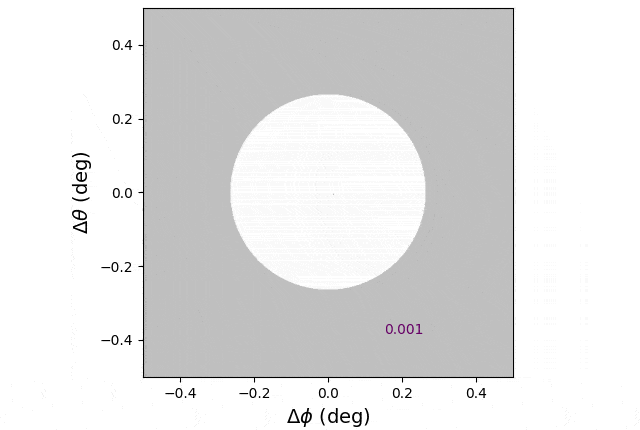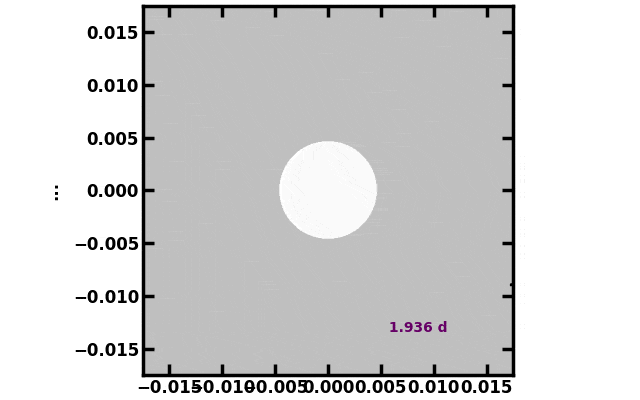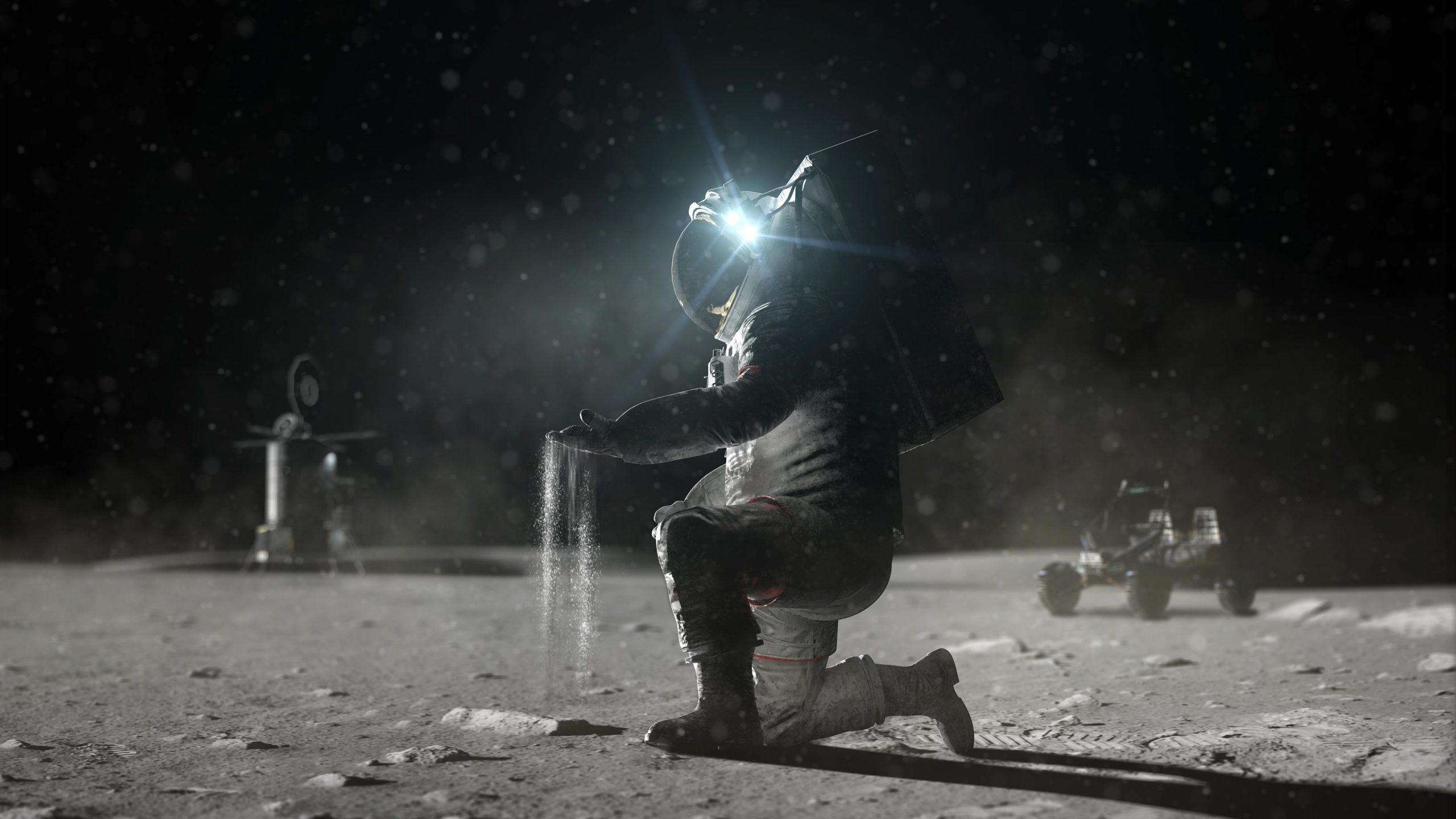Een stoffig maanlandschap, zoals gevisualiseerd door NASA’s Advanced Concepts Laboratory. Krediet: NASA
Op een koude winterdag is de warmte van de zon zeer welkom. Naarmate de mensheid echter steeds meer broeikasgassen uitstoot, houdt de atmosfeer van de aarde steeds meer zonne-energie vast en verwarmt de aarde gestaag. Een strategie om deze trend om te keren is om een deel van het zonlicht te onderscheppen voordat het onze planeet bereikt. Decennia lang hebben wetenschappers overwogen om schermen, objecten of stofdeeltjes te gebruiken om voldoende zonnestraling te blokkeren – tussen 1 of 2% – om de effecten van de opwarming van de aarde te verzachten.
Een studie onder leiding van de Universiteit van Utah onderzocht de mogelijkheid om stof te gebruiken om zonlicht af te weren. Ze analyseerden de verschillende eigenschappen van de stofdeeltjes, de hoeveelheden stof en de banen die het meest geschikt zijn om de aarde te schaduwen. De auteurs ontdekten dat het afschieten van stof van de aarde naar een station op weg naar het “Lagrangiaanse punt” (L1) van de aarde en de zon efficiënter zou zijn, maar astronomische kosten en inspanning zou vergen. Een alternatief is om moondust te gebruiken. De auteurs beweren dat het vrijkomen van maanstof van de maan een goedkope en effectieve manier zou kunnen zijn om de aarde te schaduwen.

Gesimuleerde vrijlating van een stofstroom tussen de aarde en de zon. Deze stofwolk verschijnt als het de zonneschijf kruist, vanaf de aarde. Stromen zoals deze, inclusief de stromen die vanaf het maanoppervlak vrijkomen, zouden kunnen dienen als een tijdelijke paraplu voor de zon. Credits: Ben Bromley/Universiteit van Utah
Het team van astronomen paste een techniek toe die wordt gebruikt om de vorming van planeten rond verre sterren te bestuderen, wat hun gebruikelijke onderzoeksfocus is. Planeetvorming is een chaotisch proces waarbij veel kosmisch stof vrijkomt dat ringen rond de gastster kan vormen. Deze ringen onderscheppen het licht van de centrale ster en stralen het opnieuw uit op een manier die we op aarde kunnen waarnemen. Een manier om sterren te ontdekken die nieuwe planeten vormen, is door naar deze stoffige ringen te zoeken.
“Dat was de kiem van het idee”, zegt Ben Bromley, hoogleraar natuurkunde en astronomie en hoofdauteur van de studie.

Simulatie van stof dat vrijkomt uit het waystation bij Lagrange punt 1. De schaduw op de grond is overdreven voor de duidelijkheid. Krediet: Ben Bromley
zei Scott Kenyon, co-auteur van de studie van het Center for Astrophysics | Harvard en Smithsonian.
Het artikel is onlangs gepubliceerd in het tijdschrift PLOS klimaat.
schaduw werpen
De algehele effectiviteit van het schild hangt af van zijn vermogen om een baan te behouden die de aarde in de schaduw stelt. Sameer Khan, een niet-gegradueerde student en co-auteur van de studie, leidde de eerste verkenning dat orbitalen stof lang genoeg op hun plaats konden houden om voor voldoende schaduw te zorgen. Khan’s werk toonde aan hoe moeilijk het is om stof te houden waar je het wilt hebben.
“Omdat we de locaties en massa’s van de belangrijkste hemellichamen in ons zonnestelsel kennen, kunnen we eenvoudig de wetten van de zwaartekracht gebruiken om de gesimuleerde positie van het zonnescherm in de loop van de tijd voor verschillende banen te volgen, ” zei Khan.
Er waren twee veelbelovende scenario’s. In het eerste scenario plaatsen de auteurs een ruimteplatform op het L1 Lagrange-punt, het dichtstbijzijnde punt tussen de aarde en de zon waar de zwaartekracht in evenwicht is. Objecten in Lagrangiaanse punten hebben de neiging om op een pad tussen twee hemellichamen te blijven, en dat is de reden waarom[{” attribute=””>James Webb Space Telescope (JWST) is located at L2, a Lagrange point on the opposite side of the Earth.

A simulation of dust launched from the moon’s surface as seen from Earth. Credit: Ben Bromley
In computer simulations, the researchers shot test particles along the L1 orbit, including the position of Earth, the sun, the moon, and other solar system planets, and tracked where the particles scattered. The authors found that when launched precisely, the dust would follow a path between Earth and the sun, effectively creating shade, at least for a while. Unlike the 13,000-pound JWST, the dust was easily blown off course by the solar winds, radiation, and gravity within the solar system. Any L1 platform would need to create an endless supply of new dust batches to blast into orbit every few days after the initial spray dissipates.
“It was rather difficult to get the shield to stay at L1 long enough to cast a meaningful shadow. This shouldn’t come as a surprise, though, since L1 is an unstable equilibrium point. Even the slightest deviation in the sunshield’s orbit can cause it to rapidly drift out of place, so our simulations had to be extremely precise,” Khan said.
In the second scenario, the authors shot lunar dust from the surface of the moon towards the sun. They found that the inherent properties of lunar dust were just right to effectively work as a sun shield. The simulations tested how lunar dust scattered along various courses until they found excellent trajectories aimed toward L1 that served as an effective sun shield. These results are welcome news, because much less energy is needed to launch dust from the moon than from Earth. This is important because the amount of dust in a solar shield is large, comparable to the output of a big mining operation here on Earth. Furthermore, the discovery of the new sun-shielding trajectories means delivering the lunar dust to a separate platform at L1 may not be necessary.
Just a moonshot?
The authors stress that this study only explores the potential impact of this strategy, rather than evaluate whether these scenarios are logistically feasible.
“We aren’t experts in climate change, or the rocket science needed to move mass from one place to the other. We’re just exploring different kinds of dust on a variety of orbits to see how effective this approach might be. We do not want to miss a game changer for such a critical problem,” said Bromley.
One of the biggest logistical challenges—replenishing dust streams every few days—also has an advantage. Eventually, the sun’s radiation disperses the dust particles throughout the solar system; the sun shield is temporary and shield particles do not fall onto Earth. The authors assure that their approach would not create a permanently cold, uninhabitable planet, as in the science fiction story, “Snowpiercer.”
“Our strategy could be an option in addressing climate change,” said Bromley, “if what we need is more time.”
Reference: “Dust as a solar shield” by Benjamin C. Bromley, Sameer H. Khan and Scott J. Kenyon, 8 February 2023, PLOS Climate.
DOI: 10.1371/journal.pclm.0000133

“Bierliefhebber. Toegewijde popcultuurgeleerde. Koffieninja. Boze zombiefan. Organisator.”







More Stories
Een nieuw rapport zegt dat het gebruik van ras en etniciteit soms “schadelijk” is in medisch onderzoek
SpaceX lanceert 23 Starlink-satellieten vanuit Florida (video en foto’s)
NASA zegt dat de “Halloween-komeet” zijn vlucht langs de zon niet heeft overleefd